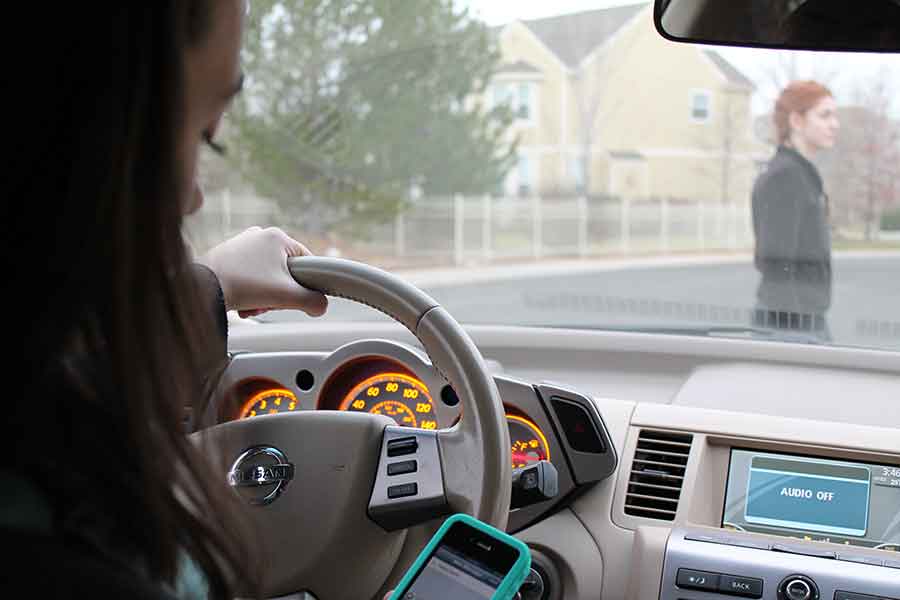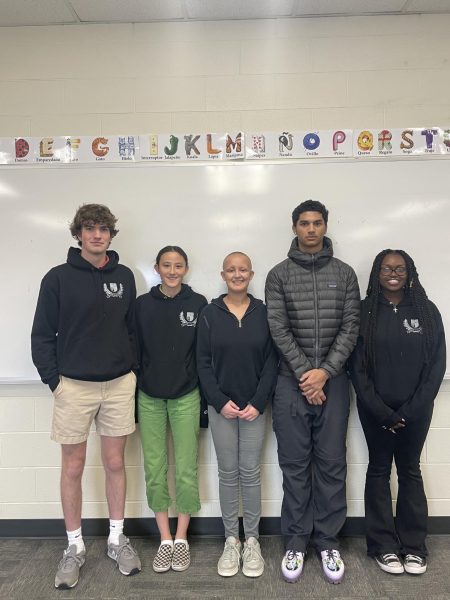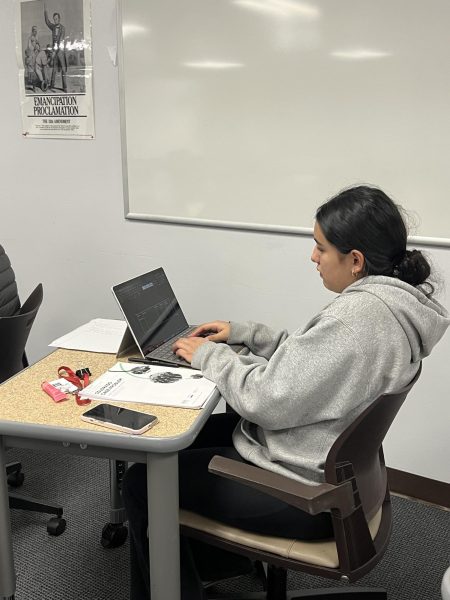Driving While Intexticated
Would you trade your life to send a text message?
The message of “don’t drink and drive” is plastered all over our society. From beer commercials to speeches by worried parents, all teenagers are widely exposed to the very real, very dangerous threat that is driving while intoxicated. Drinking and driving seems to be, or is at least presented as, the most serious and deadly driving offense anyone can make.
False.
A study by the National Highway Traffic Safety Administration busts this myth by declaring that driving a vehicle while texting is six times more dangerous than driving while intoxicated.
Six times.
As concerning as those dangers are, how common people text and drive simultaneously is surprising as well. Everything from the inability to leave a cell phone packed away in the center console, to simply believing that your driving skills are good enough to handle this challenge can lead someone to abandon safe driving practices and glance down at their cell phone.
That short interval of distraction kills. Literally.
All too often people end up in the hospital or dead because of the careless and selfish decision of another driver. That other driver can end up paying extensive amounts of money in damages or even getting booked in jail.
Something about that image represents a clear issue in our society, an issue that the media and individuals themselves are trying to address. The obvious answer to just have the strength and willpower to refrain from cell phone use behind the wheel isn’t enough. Prevention is the only solution.
Stop texting and driving. Save people money. Save lives.
Driving While Intexticated: Easy as One, Two, Three
Truth or dare? Dare? Okay. During the Broncos game this weekend, drive your car the length of the field, blindfolded. No? Come on, it’ll only take about five seconds. Why not? You think it’s dangerous? You could hurt someone? Kill someone? Then tell me this:
Why would you text and drive?
The Virginia Tech Transportation Institute found in a 2009 study that “text messaging [while driving] had the longest duration of eyes-off-road time (4.6-second over a six-second interval). This equates to a driver traveling the length of a football field at 55 miles per hour without looking at the roadway”.
If it is so dangerous, then why do so many people do it? It seems so simple: two hands on the wheel, two eyes on the road.
In a customer survey by AT&T, the cell phone company widely known for their anti-texting while driving It Can Wait campaign, 98 percent of commuters agreed unanimously that sending a text or email while driving is dangerous; yet, knowing the risks, 49 percent said they have simultaneously texted and driven. 40 percent of these have described it as a personal habit, maybe even an addiction.
“Neuro-imaging has shown that back and forth texting floods the pleasure centers of the brain, the same area that lights up when using heroin,” said Suzanne Phillips, a licensed Psychologist, Psychoanalyst, and an Adjunct Professor of Clinical Psychology in the Doctoral Program of Long Island University. “The addictive potential is obvious.”
One sign of an addict is their willingness to take senseless risks in order to obtain their “substance,” which makes it dangerous to dismiss teens’ constant texting as harmless or just what teens do these days.
Teens today think they are invincible; there is a sharp focus in their minds on karma, rather than judgment, particularly regarding motor vehicle crashes. Texting without even looking at the screen, a “skill” widely popular and valued amongst our youth, becomes a habit so mindlessly formed that they believe their self-proclaimed expertise will immortalize them.
Jordan Levine, a personal injury lawyer at Levine Law in Denver, Colorado, says it’s all about resisting the temptation. “You think you can do it, that you’re the one who can handle it, but you can’t,” Levine said. “You injure someone just by looking at your phone.”
News flash: your talent will not save you if you crash, nor will it prove you innocent in a court of law.
The Legal Ramifications Of Texting and Driving
Look at the last text message you sent.
Now consider this: Would you pay $50 to send that text? Would you trade those few words for a few years in jail?
Probably not.
Sending that one text though, can result in $50 out of your own pocket and one point on your driver’s license. Not to mention that you can seriously injure or even kill someone.
The Official U.S. government website for distracted driving lists that texting and driving is illegal in 41 states including the state of Colorado.
Issue Brief Number 10-04 by the Colorado Legislative Council Staff outlines the specific the legal ramifications for sending a single text while behind the wheel. Those consequences are steep.
This seemingly insignificant act can result in points on your driver’s license and a fine of $50 to $100, depending on your age and previous offenses.
The consequences are even greater if an accident is caused by someone who is texting and driving. Levine describes the damages that someone may have to pay if an automobile accident occurs:
“Compensatory damages [are] for medical expenses, car repair, or even for your pain and suffering. Punitive damages are a second category of damages for reckless conduct which insurance does not cover. So, the client is paying those damages their self,” Levine said.
Most people, however, do not consider the legal consequences of their convenient text conversations while driving. Avoiding cell phone use behind the wheel can not only result in saving a significant amount of money, but saving someone’s life as well.
Cohen Children’s Medical Center in New Hyde Park released a staggering statistic that there are “more than 3,000 annual teen deaths nationwide from texting and driving and 300,000 injuries.”
Those are 3,000 deaths that are entirely preventable. The Distracted Driving Foundation published an article stating that ending someone’s life because of an instinctive decision to reply to a text message can result in a stay in jail.
If being forced to pay a significant sum of money to the government isn’t enough of a dissuading factor to not text and drive, cutting a life short and winding up in jail is.
Because of the serious risks of texting and driving, now more than ever police officers are on the lookout for these distracted drivers. Issue Brief Number 10-04 by the Colorado Legislative Council Staff states that drivers can be stopped for use of their cell phone without being stopped for another offense. Law enforcement officers simply must see you typing a text and they can write a ticket.
This is becoming a common phenomenon for police officers not just in Colorado but across the entire country.
A Yahoo! News article from November describes how New York state police officers are even more conscious of distracted drivers with their cell phones in hand. The police officers are driving in large black, undercover SUVs to peer down at drivers and look for cell phones.
Distracted drivers certainly hope one of these black SUVs doesn’t pull up next to their car.
The legal consequences of texting and driving are extreme and must be considered before getting behind the wheel. But, even more than fees or jail time, the injuries and even deaths that can result from texting and driving have devastating effects on many lives every day.
What Is a Text Worth? Surely Not Your Life
Twisted metal and shards of broken glass litter the road as emergency responders work quickly and carefully to free three young women from the mangled heap that was once their car.
Flashback to only a few seconds earlier.
The girls in the car are laughing and smiling, teasing each other about a boy. A boy that the driver then decides to text while driving. She only takes her eyes off the road for a moment, but before she knows it, the car is crossing the center line of the road and colliding head on with another vehicle. After spinning and then screeching to a stop, the car is then impacted again by oncoming traffic.
When the driver realizes what has happened, she is visibly distraught. However, when the young woman takes in the sight of her two companions near her in the vehicle, unmoving and grotesquely injured, her distress is uncontainable, and she begins to scream.
This is the scene of a texting and driving accident as depicted in a short film made by the Heddlu Gwent Police force in Wales, which gained media attention when New York Daily News online reported about it on August 25, 2009. Although considered gruesome by some viewers due to the extent of the injuries sustained in the accident, the dramatization in this video is being used as a tool to get drivers to “think twice before picking up their mobile phone when behind the wheel and realize that a quick reply to a text message or answering a phone call is never worth putting theirs and other people’s lives at risk” says John Pavett, who is Chief Inspector for the Gwent Police force.
And even though the injuries depicted in the film are on the extreme end of the spectrum, as they are meant to shock drivers into reconsidering before texting behind the wheel, it would be false to say that such an extreme category of injuries are rare in texting and driving accidents.
Brandi Williams, the Injury Prevention/Trauma Coordinator for The Medical Center of Aurora in Colorado, says that an injury sustained in a car accident, whether or not the cause was texting and driving “can be something as simple as an abrasion or it can lead to death.” She adds that the varieties of injuries commonly sustained in motor vehicle accidents are “Head trauma, rib fractures, solid organ injury, pelvic trauma and multiple broken bones.”
Williams then provides insight on one of the reasons for the danger texting and driving poses when she says that “often distracted drivers are not paying attention to their surroundings and do not see the biker on the side of the road or the child crossing the street to get a ball. It does not only affect the passengers in the vehicle. Texting accidents involve everything that surrounds the vehicle as well.”
This statement by Williams relates back to Chief Inspector Pavett’s hope that the graphic film produced by the Heddlu Gwent Police force would push drivers to think of the well being of others and themselves before texting behind the wheel. To think of the value of life. Is it worth a text?
Influential Groups in Media are Working to Raise Awareness Against this Popular Trend
Look at your television. What do you see? Chances are you will come across a texting and driving commercial.
With texting and driving becoming more prevalent in today’s world, the media is trying to reach out and stop this epidemic by raising awareness of the dangers of texting and driving.
Since this habit stems from the majority of people having cell phones, many phone companies are starting to step up with campaigns against this new trend. AT&T is one of the major leaders in the media with their It Can Wait campaign. This campaign features commercials of real life families who have been affected by a texting and driving accident.
AT&T has also created a website for their campaign. This website features true stories of people that have been involved in texting and driving incidents. By publishing these stories, it inspires people to take the It Can Wait pledge on the website. When taking the pledge, you are making the promise to abstain from texting while driving.
To show the dangers of texting and driving, AT&T has also added a simulator so people can experience the feeling of this distressing distraction.
Although AT&T is one of the top promoters against texting while driving, they are not the only ones. Many popular television shows use their programs to explain the dangers of texting behind the wheel.
Fox’s hit show Glee filmed an episode in its third season that demonstrated the dangers of being on your phone while driving. In the episode, Quinn Fabray, played by Dianna Agron, was on her way to a wedding, but couldn’t resist the urge to pick up her phone and send an ‘On my way’ text to the bride.
Although she just looked down for a few seconds, those seconds made a difference.
While typing out this message, she ran a stop sign, was hit by an oncoming driver, and suffered serious injuries. Glee not only illustrated the short term effects of texting while driving, but continued to display long term effects throughout the season, the remainder of which Quinn spent in a wheelchair while she relearned how to walk. By doing this, Glee was able to demonstrate just how dangerous this habit can be.
This message from Glee is especially powerful because it speaks directly to the target audience: teenagers. Teenagers are the ones who are most culpable for texting and driving, so hearing this message from a television show they identify with can have a resounding impact.
People of all ages look to the media for inspiration and are easily influenced by the choices people in the limelight make. Seeing the dangers of texting and driving on screen captivates people’s attention and makes them aware of a common situation.
“Education is the key to preventing texting and driving,” Denver Firefighter Erik Burkhalter said.
This is precisely what the media is attempting to do. They are hoping to educate people about the ramifications of texting and driving.
The media is using their influence to make a change and potentially save lives.
The Key to Making it Stop is Not Letting it Start
In a 2009 study by Car and Driver Magazine, a car was rigged with a red light to signal drivers when to brake, and it documented that the reaction time was much slower for texting drivers than for those legally drunk at .08 BAC.
This has become an undisputed fact amongst other studies over the past decade. Yet, we as a society are far more horrified at drunk drivers than texting drivers. Why? Because we as a nation text and drive constantly. Although there are many other distractions to the primary task of driving – such as eating, using a GPS, or adjusting the radio – texting is the most distressing because it requires a person’s visual, manual, and cognitive attention.
So what are we supposed to do? Leave our phones at home? In today’s exceptionally communicative society, this becomes very unrealistic of a request.
Nevertheless, in order to reduce the temptation, AT&T launched in 2013 the DriveMode® app, available strictly for AT&T Android and Blackberry users through Google Play, BlackBerry App WorldTM, and the AT&T AppCenter. The app, part of the company’s It Can Wait campaign, “can be set up to automatically send a customizable reply…similar to an ‘out-of-office alert’…[to incoming texts, emails and wireless calls] when the vehicle starts moving 25 mph”.
This is only one way in which a person may pledge to not text and drive. Others are simpler. Much simpler, in fact:
Just say something.
In an NHTSA survey of over 6,000 drivers, “almost all…considered a driver who was sending or reading text messages or e-mails as very unsafe.” Despite this, only one-third of passengers ages 18 to 24 said they, as passengers, would confront the driver about it.
Why is this? Why are people so hesitant to stand up for their own safety – for their own lives?
“Showing bad habits of calling and talking on the phone while driving…will rub off. Speak up,” Dale Weese, a sales representative at American Family Insurance, said.
Regis Jesuit sophomore Claire Bergstrom, approximately two months a licensed driver, agrees with Weese. When asked her thoughts on riding with a texting driver, Bergstrom said. “It makes it seems like it’s not a big deal; I feel like if I see them doing it, it’s okay if I do it, too.”
Bergstrom adds, in reference to the AT&T It Can Wait advertisements, “I see them, and I know what they are saying, but they do not have much of an impact on me.”
If this is true for more than just Bergstrom, which must be the case due to the staggering statistics on drivers who simultaneously use their phones, then what, if anything, is the solution? Levine says awareness is key.
“Awareness is the most important way to eliminate it because you understand the ramifications and know that you could be hurting someone. You can really change someone’s life,” Levine said. “You are deciding that picking up the phone is more important than safety…you can’t [do that].”
Your text messages will still be there when you arrive at your destination. Will you?
In Conclusion
Texting and driving is a very serious issue in today’s society. As demonstrated, it has long term effects that hurt people of all ages. Despite the propaganda in the media and the new formed laws, texting behind the wheel continues to cause accidents daily. As a society, many are reaching out to prevent this new trend from continuing. While this has influenced some, many are still participating in the act of driving while on a cell phone.
It is an addictive and harmful habit, but it can be stopped.










